India ~ Day 3
Brought to you by: 

In which auspiciousness is ensured and thali is consumed
“Go, eat! Eat! Eat!”
The dictate to dine follows Sheri and I as we hustle through the wedding hall. Though we’re here this morning to get henna’d, we must first obey the munching orders issued by Raja’s maternal aunts. The wedding reception is tonight, followed tomorrow morning by the ceremony, which is traditional in many Hindu families. This morning, the women gather to futz over the marriable duo, prepare for tonight’s celebration, enjoy quality family time, and have mehndi (henna) applied.
So in we dig – with socially proper right hand only – into our first thali, or simply “meal.” We eat feast style, seated along one side of an extremely long and shallow table. At each place setting, a broad green banana leaf is set and sprinkled with water that is spread with the palm of the hand. A line of server-men then pace the length of the table, ladling food from heavy, steaming pots. Food is served up loose in scoops and puddles along with roti (breads), pickled concoctions, sauces, cool curd (unsweetened yogurt), and super sugary desserts – all in all, perhaps two dozen items. Vegetarian never tasted so good.
Munch a little of this shaved coconut concoction, mix some of the mushy corn stuff with rice and that scary bright red chile stuff, now shove down some curd because that red stuff was riotously hot; pick up a little masala’d potatoes with chapatti, a chewy, griddle-fried wheat flatbread; hmm, I think this one’s okra; drench a savory, deep fried, donut-shaped vada in saucy lentil sambar; nibble on puri, flatbread fried until it puffs crispy thin; and alternate all the salty spice with a slice of banana rolled in sugar, a sip of chai, or a blob of kheer, a cardamom-infused rice pudding.
The most fatal-to-your-stomach mistake is to confess, “Oh man, I love this stuff…whatever it is!” whereby you’ll get a double-ladle of your new favorite with a gigantic, pleased smile from the server boss. This thali (and every other thali during the wedding) is among the most intense food experiences I’ve had – for the sheer variety and quantity and newness and goodness and dunno-what-I’m-eating-ness.
Once sated, Sheri and I decide that, before our henna encounter, we desperately need to walk off breakfast with a bout of shopping at the nearby outdoor market. Our goals are bindis (the holy dots worn on the forehead by women) and bangles to accessorize our saris, but we are also keen to poke around the neighborhood. On the way, we pass sidewalk chefs who supply simple lunches from well-used simmering pots as well as hordes of loitering auto-rickshaw drivers taking a break from their rides in the cool tree shade. The air of the busy market is sweetened by garlands of fresh flowers that hang along the aisles and drape between the tops of the booths; garlands that glow like stained glass as high noon sunlight flushes through them.
We find row upon row of bangles of glass and metal, decorated with glitter and paint, and offered in every color. We successfully haggle – at least by our non-aggressive novice standards – getting a fair going rate for our jangly and shiny doo-dads. Sheri and I then torment an obliging shopkeeper, poring over dozens of salwar kameez sets and breezy shirts for our expanding Indian wardrobes. On our return to the wedding hall, one of Raja’s doting aunts gently berates us for not wrangling over the price-tagged clothes that by our standards are ridiculously cheap (just $4.00 for a fantastic shirt). She says, “You see, the tags there mean nothing. You must not let them get away with such prices. Though it doesn’t seem like much money to you, it is too much to us.” Chastised and clued in, we hustle off to another tasty thali for lunch.
After eating, we’re ready for mehndi, so here we go. Viscous muddy henna is painstakingly squeezed in a thin line by the steady hands of one of Raja’s female relatives. Plant-inspired swirly motifs appear on my doodleless skin. Then time slows and slows to an agonizing, itchy, evaporative crawl as I wait and wait for the henna to dry. The natural plant-based dye takes hours and hours to stain the skin properly, and I go two before I lose my cool and pick off the air-stiffened pieces revealing a bright orange temporary tattoo. The bride-to-be suffers for more than twice my time with sticky henna inhibiting the use of her hands and feet – unable to scratch her nose, adjust her heavy gold wedding jewelry, brush back her hair, twiddle her thumbs, re-tuck her shiny sari, take a leak, shoo a fly, or feed herself – all so her henna becomes as dark as possible to engender an auspicious marriage.
Sarah eventually has a quadriplegia-induced panic attack, anxiously crying out: “Get it off me! NOW!!” The shade of her henna will have to be auspicious enough.
Sheri and I return to the Hotel President to change into our festive wedding reception outfits and meet up with Todd, who has been on a solo exploration of Chennai.
We make a quick turnaround back to the wedding hall, where Raja’s relatives welcome us to the party with the help of a brass band decked out in full-on marching band gear. Raja’s father snatches us from our onlooker reverie and dances us into the hall where we join dozens of other grooving guests, dripping sweat in the humid evening. Typically, the family would wait for the groom’s arrival before high-gearing the revelry, but this family is too joyful to bother with formalities, and we don’t know the difference anyway.
The party moves from inside the wedding hall to a nearby side street where we wait for Raja’s arrival by horse-drawn, umbrella-topped chariot from the nearby temple. The band keeps up the festive mood with their rowdy trumpeting and drumming, generator-driven lights bring back daylight, and no one is allowed to stop dancing, even as cars and motorcycles squeeze through our shimmying rabble that fills the entire narrow, unpaved, and normally quiet road. An aunt tells me, “Arms up, shake your hands. This is how you dance at a wedding.”
The celebration peaks as Raja-on-chariot arrives and trundles back to the hall, where Sarah is escorted to the side of her soon-to-be, and where strings of firecrackers are lit and avoided. The dancing returns from whence it came, back into the hall where we break for juice as sweet and viscous as concentrate while angling for a breezy spot directly beneath one of the overhead ceiling fans.
Joy! Another tremendous thali for dinner. After eating more than our fill, we watch as Raja and Sarah sit on thrones and endure giddy relatives taking their photos ad nauseam – eventually their smiles wear them instead of vice versa. Then we all sit back in plastic patio chairs and contentedly listen as Raja’s aunties and other women sing traditional Hindu songs in call-and-response to the mostly male, young cousins’ less-practiced renditions of Bollywood pop hits; it’s a genial, inter-generational Indian karaoke face-off.
Though the party ultimately peters out, six of us young Americans are not too pooped to get a cold beer before bed. Except at bars and clubs in the mega-hotels, alcohol is not readily available in Chennai, a city almost as dry as it is beef-free. Chennai’s state of Tamil Nadu only got around to ending its fiercely nationalistic prohibition in 1984, and public drinking is still uncommon.
Our group enters the pub-like bar of the nearby and ritzy Hotel Residency, still dressed to the nines in our eclectic wedding gear: Sheri in a formal black and gold choli sharara, me in a black salwar kameeze, Heather in a Thai-style lavender silk suit, Tanya in a straight-up sari, and Dave and Todd in identical and attention-getting shirwanis. Our conspicuous group gets its share of stares in the pub from the western-aspiring Indian hipsters who relentlessly drag on cigarettes and dig 80s hits and crap-hop music.
Sipping our tasteless and refreshing Kingfisher beers, we notice a wrap-around second-floor balcony above our heads, populated by men who happily drink, dance and socialize only with other men; apparently, it’s common practice for bars to segregate men without a female companion away from couples and groups of women. A net protects the mixed-gender crowd below from falling glasses and bottles.
Before calling it a night, we roam the hotel, and happen on another Hindu wedding reception in one of the ballrooms. Furtively, we poke our heads through the open doors in a bit of “my friend’s wedding is better than yours” nosiness.
As we try to scurry off unnoticed, a few of the guys at the wedding – seeing our foreign group’s curiosity and exuding nuptially-required generosity – invite us in. We are first urged onto a stage to stand with the bride and groom for yet more photo ops and a bit of video documentation of the wacky Americans who crashed the wedding party. After congratulating the bewildered couple, we step down from the stage and matrons quickly surround our group to examine our mehindied hands, pluck at our South Asian-mishmash attire, and wheedle more food on our already topped-off tummies. We are introduced to the newlyweds’ parents, who are absurdly appreciative that we have uninvitedly joined them for this family occasion.
In which auspiciousness is ensured and thali is consumed
“Go, eat! Eat! Eat!”
The dictate to dine follows Sheri and I as we hustle through the wedding hall. Though we’re here this morning to get henna’d, we must first obey the munching orders issued by Raja’s maternal aunts. The wedding reception is tonight, followed tomorrow morning by the ceremony, which is traditional in many Hindu families. This morning, the women gather to futz over the marriable duo, prepare for tonight’s celebration, enjoy quality family time, and have mehndi (henna) applied.
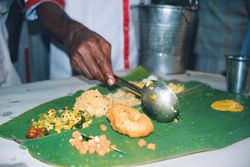 |
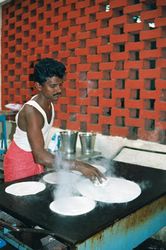 |
The most fatal-to-your-stomach mistake is to confess, “Oh man, I love this stuff…whatever it is!” whereby you’ll get a double-ladle of your new favorite with a gigantic, pleased smile from the server boss. This thali (and every other thali during the wedding) is among the most intense food experiences I’ve had – for the sheer variety and quantity and newness and goodness and dunno-what-I’m-eating-ness.
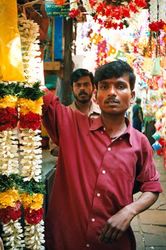 |
| Garlands at Chennai Market. Photo by Lauren Girardin. |
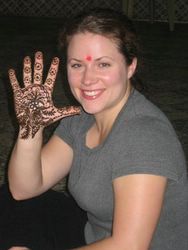 |
| Henna hand. Photo by Sheri Holtzman. Click to enlarge. |
We find row upon row of bangles of glass and metal, decorated with glitter and paint, and offered in every color. We successfully haggle – at least by our non-aggressive novice standards – getting a fair going rate for our jangly and shiny doo-dads. Sheri and I then torment an obliging shopkeeper, poring over dozens of salwar kameez sets and breezy shirts for our expanding Indian wardrobes. On our return to the wedding hall, one of Raja’s doting aunts gently berates us for not wrangling over the price-tagged clothes that by our standards are ridiculously cheap (just $4.00 for a fantastic shirt). She says, “You see, the tags there mean nothing. You must not let them get away with such prices. Though it doesn’t seem like much money to you, it is too much to us.” Chastised and clued in, we hustle off to another tasty thali for lunch.
After eating, we’re ready for mehndi, so here we go. Viscous muddy henna is painstakingly squeezed in a thin line by the steady hands of one of Raja’s female relatives. Plant-inspired swirly motifs appear on my doodleless skin. Then time slows and slows to an agonizing, itchy, evaporative crawl as I wait and wait for the henna to dry. The natural plant-based dye takes hours and hours to stain the skin properly, and I go two before I lose my cool and pick off the air-stiffened pieces revealing a bright orange temporary tattoo. The bride-to-be suffers for more than twice my time with sticky henna inhibiting the use of her hands and feet – unable to scratch her nose, adjust her heavy gold wedding jewelry, brush back her hair, twiddle her thumbs, re-tuck her shiny sari, take a leak, shoo a fly, or feed herself – all so her henna becomes as dark as possible to engender an auspicious marriage.
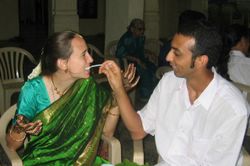 |
Sheri and I return to the Hotel President to change into our festive wedding reception outfits and meet up with Todd, who has been on a solo exploration of Chennai.
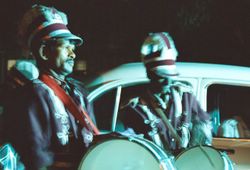 |
| Wedding musicians. Photo by Lauren Girardin. |
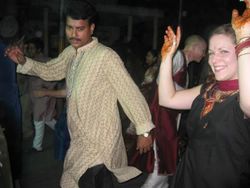 |
| Photo by Sheri Holtzman. |
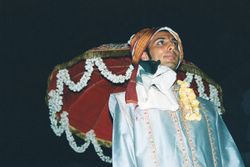 |
| Raja-on-chariot. Photo by Lauren Girardin. |
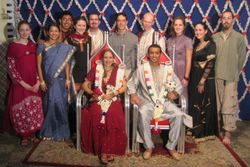 |
| American friends. Photo by unknown wedding guest. |
The party moves from inside the wedding hall to a nearby side street where we wait for Raja’s arrival by horse-drawn, umbrella-topped chariot from the nearby temple. The band keeps up the festive mood with their rowdy trumpeting and drumming, generator-driven lights bring back daylight, and no one is allowed to stop dancing, even as cars and motorcycles squeeze through our shimmying rabble that fills the entire narrow, unpaved, and normally quiet road. An aunt tells me, “Arms up, shake your hands. This is how you dance at a wedding.”
The celebration peaks as Raja-on-chariot arrives and trundles back to the hall, where Sarah is escorted to the side of her soon-to-be, and where strings of firecrackers are lit and avoided. The dancing returns from whence it came, back into the hall where we break for juice as sweet and viscous as concentrate while angling for a breezy spot directly beneath one of the overhead ceiling fans.
Joy! Another tremendous thali for dinner. After eating more than our fill, we watch as Raja and Sarah sit on thrones and endure giddy relatives taking their photos ad nauseam – eventually their smiles wear them instead of vice versa. Then we all sit back in plastic patio chairs and contentedly listen as Raja’s aunties and other women sing traditional Hindu songs in call-and-response to the mostly male, young cousins’ less-practiced renditions of Bollywood pop hits; it’s a genial, inter-generational Indian karaoke face-off.
Though the party ultimately peters out, six of us young Americans are not too pooped to get a cold beer before bed. Except at bars and clubs in the mega-hotels, alcohol is not readily available in Chennai, a city almost as dry as it is beef-free. Chennai’s state of Tamil Nadu only got around to ending its fiercely nationalistic prohibition in 1984, and public drinking is still uncommon.
Our group enters the pub-like bar of the nearby and ritzy Hotel Residency, still dressed to the nines in our eclectic wedding gear: Sheri in a formal black and gold choli sharara, me in a black salwar kameeze, Heather in a Thai-style lavender silk suit, Tanya in a straight-up sari, and Dave and Todd in identical and attention-getting shirwanis. Our conspicuous group gets its share of stares in the pub from the western-aspiring Indian hipsters who relentlessly drag on cigarettes and dig 80s hits and crap-hop music.
 |
Before calling it a night, we roam the hotel, and happen on another Hindu wedding reception in one of the ballrooms. Furtively, we poke our heads through the open doors in a bit of “my friend’s wedding is better than yours” nosiness.
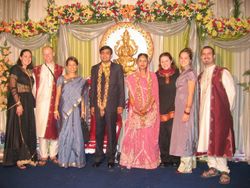 |
 Eat - Drink - Protest
Eat - Drink - Protest
<< Home